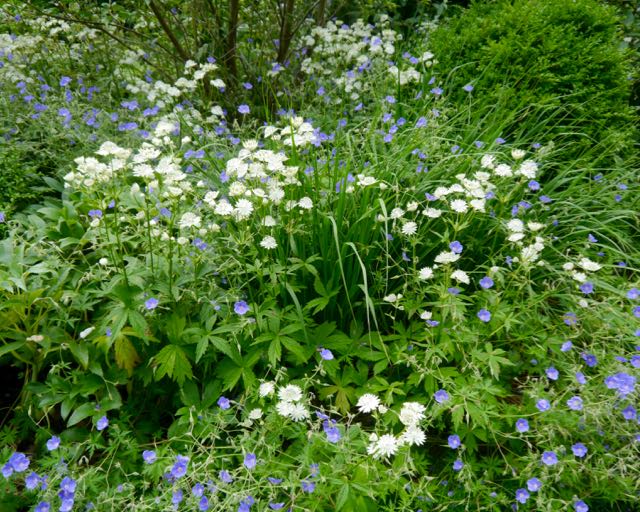Shady favourites: white and blue flowers to glow in low evening light. Shade in this case means protected from the sun during most of the day; under the canopy of large trees, or in the shade cast by buildings. Here are some example of lush planting for for these cool damp areas out of the sun: Astilbe ‘Rheinland’ is a pale pink, Astrantia major ‘Shaggy’ and ‘Large White’ have soft, green and white, pincushion flowers, a blue geranium such as ‘Orion’ makes a good contrast. Variegated hosts planted with Alchemilla mollis (Lady’s Mantle) gives a wonderful variations in texture and warm yellow colouring. A different, darker and much drier habitat occurs under low trees, evergreens and dense shrubs would not suit the above and is a problem for discussion on another day.

Astilbe
Thin apples to get fat apples: snip off extra small ones to leave only one apple per spur to ripen and swell. This is really worth doing, the tree itself will be shedding small fruit, so help it along. It might feel wasteful but contrariwise this action will give you a better crop in the end. If the tree bears a great number of small fruit one year, it will not fruit so well the next, getting eventually into the habit on only fruiting every second year.

Variegated hosta and Lady’s’ Mantle
Plums too: look out for particularly heavy crops on plums, the weight of fruit can break branches. Thin the fruit or in extremis cut back the branch. After fruiting prune cherries and related fruit trees, such as apricot, peach and plum.
Keep on cutting: have a go at deadheading the roses. This is a job for the evening when you are feeling idle. Just have a wander round the garden, smell the scents, admire your handiwork and snip off a few dead flowers. It will encourage new growth and further flowers.
Herbs too: Mediterranean herbs such as rosemary, thyme and sage should be cut back after flowering to encourage bushy new shoots for harvesting.
And the hedges: There will be masses of lush soft growth because of all the rain in June. Cut back hard now and the regrowth will be just enough to keep a soft but clear outline until the winter. Many of us have common laurel (Prunus laurocerasus, not to be confused with the edible bay Laurus nobilis) It grows quickly and copes with a range of difficult conditions so is widely planted. However these virtues can become vices if not kept in check. Its big shiny leaves will brown if cut through, so it is best to cut back using secateurs rather than power hedge trimmers.

White astrantia in woodland
Waterin’ in the Rain: Keep on with the watering of plants in pots. However much it rains, pots still need water. The leaves will act as an umbrella and nothing gets to the roots of the plants.
Feed tomatoes, courgettes and cucumbers in pots, growbags or even planted in soil. Nip off the growing tip of tomato plants above the fourth truss or when it reaches the top of the greenhouse.
Sow biennials and perennials to flower next year.
In the vegetable beds. I am going to harvest the garlic in the next couple of weeks. The broad beans and peas are over and the spinach has gone to seed. There will be space for all sorts of seedlings to go in. Trip to the nursery coming up.

Garlic harvest



